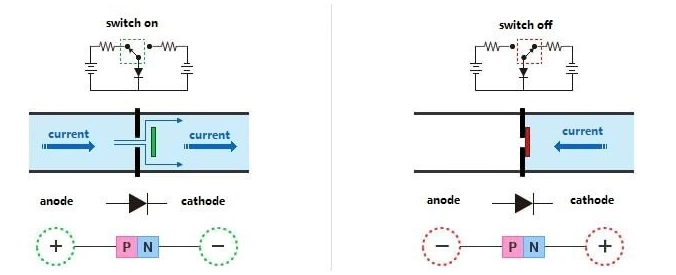
In the realm of electronics, the switching diode stands as a fundamental yet crucial component, playing a pivotal role in various circuits and devices. Its capability to control the flow of electrical current in one direction with minimal voltage drop distinguishes it among other semiconductor devices.
What is a Switching Diode?
A switching diode, often referred to as a signal diode, is a semiconductor device engineered to conduct current predominantly in one direction. Unlike regular diodes used in rectification, which convert AC to DC, switching diodes are specifically designed for high-speed switching applications.
The Working Principle of a Switching Diode
At its core, the operation of a switching diode is grounded in the behavior of semiconductor materials and their unique properties. The diode is typically fashioned from silicon or germanium, both semiconductor materials known for their conductive properties under specific conditions.
P-N Junction: The Key to Its Function
A switching diode consists of two distinct regions: the P-type semiconductor (positively doped) and the N-type semiconductor (negatively doped), creating what’s called a P-N junction. This junction is the cornerstone of the diode’s operation.
When a forward bias voltage is applied across the diode, meaning the positive terminal of a voltage source connects to the P-region and the negative terminal connects to the N-region, it allows the free movement of charge carriers. Electrons flow from the N-type region to the P-type region while holes move in the opposite direction.
Conversely, in a reverse bias condition, where the positive terminal connects to the N-region and the negative terminal connects to the P-region, the depletion zone widens. This restricts the flow of charge carriers, preventing current from passing through the diode, except for a negligible reverse current called leakage current.
Applications of Switching Diodes
High-Speed Switching Circuits
One of the primary applications of switching diodes lies in their ability to rapidly switch between conducting and non-conducting states. This property is exploited in high-speed digital circuits where quick switching is imperative, such as in signal demodulation, digital logic gates, and radio frequency (RF) applications.
Clipping and Clamping Circuits
Switching diodes find use in clipping and clamping circuits, essential in signal processing. Clipping circuits limit the amplitude of a waveform by removing portions of it beyond a certain threshold, while clamping circuits alter the DC level of a signal without changing its shape.
Voltage Regulation
In voltage regulation circuits, Zener diodes, a specialized type of diode operating in reverse breakdown voltage, are often used to stabilize and regulate voltage levels.
Challenges and Advancements
While switching diodes offer remarkable advantages, they are not exempt from challenges. Heat dissipation, voltage spikes, and leakage currents pose challenges in high-frequency applications. However, ongoing research and advancements in semiconductor technology continuously strive to mitigate these issues, leading to more efficient and reliable diodes.
Conclusion
The switching diode’s role in modern electronics cannot be overstated. Its ability to swiftly switch between conducting and non-conducting states has revolutionized numerous technological domains, contributing to the advancement of telecommunications, computing, and signal processing.
As technology progresses, the evolution of switching diodes persists, driving innovation and shaping the landscape of electronics, promising a future where faster, more efficient, and reliable devices become the norm.
In essence, the modest switching diode remains an unsung hero, quietly powering the seamless functioning of countless electronic devices and systems we interact with daily.
